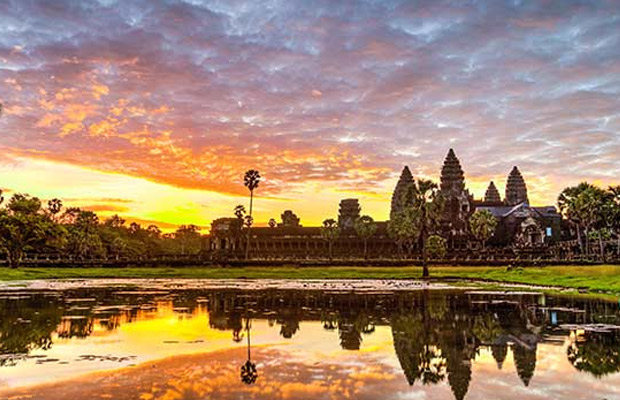Angkor Wat: A Masterpiece of Khmer Architecture

Angkor Wat, located in Siem Reap, Cambodia, is the largest religious monument in the world and a UNESCO World Heritage Site. Built in the early 12th century during the reign of King Suryavarman II, this architectural marvel was originally dedicated to the Hindu god Vishnu before transitioning into a Buddhist temple. It symbolizes the pinnacle of Khmer engineering, art, and devotion.
Historical Background
Constructed between 1113 and 1150, Angkor Wat was designed to serve as the king’s state temple and mausoleum. It reflects the Khmer Empire’s immense wealth, power, and architectural innovation. Unlike other Angkorian temples, Angkor Wat faces west, a direction often associated with Vishnu and death, suggesting it was also intended as a funerary monument.
Over time, Angkor Wat transitioned into a Buddhist temple, beginning in the late 12th century, as Buddhism became increasingly prominent in the region. It remains an active place of worship to this day, blending Hindu and Buddhist traditions.
Architectural Highlights
- Grand Scale and Design
Angkor Wat covers approximately 162 hectares and is surrounded by a large moat, symbolizing the cosmic ocean. Its design is a three-tiered pyramid crowned by five central towers, representing Mount Meru, the mythical home of the gods in Hindu and Buddhist cosmology. - Intricate Bas-Reliefs
The temple is famous for its bas-reliefs, which stretch over 800 meters and depict scenes from Hindu epics like the Ramayana and Mahabharata, as well as historical events. Notable panels include:- The Churning of the Ocean of Milk: A vivid depiction of gods and demons working together to extract the elixir of immortality.
- The Battle of Kurukshetra: A scene from the Mahabharata showcasing divine and human warriors in combat.
These intricate carvings not only highlight the artistic skill of Khmer artisans but also serve as spiritual and historical narratives.
- Central Sanctuary
The temple’s central tower rises to a height of 65 meters and is accessible via steep staircases, symbolizing the arduous journey to the heavens. Inside, the sanctuary houses a statue of Vishnu (and later Buddha), underscoring the temple’s spiritual significance. - Symmetry and Precision
Angkor Wat is renowned for its symmetry and harmonious proportions, which align with Khmer architectural principles. Its layout is meticulously planned, incorporating astronomical alignments and intricate geometrical patterns.
Cultural and Spiritual Significance
Angkor Wat represents the fusion of religion, art, and politics in the Khmer Empire. It served not only as a spiritual center but also as a symbol of the empire’s authority and divine connection. Today, it remains a pilgrimage site for Buddhists and a source of national pride for Cambodia, appearing on the country’s flag.
Conservation and Legacy
Rediscovered by Western explorers in the 19th century, Angkor Wat became a symbol of Cambodia’s rich history. Conservation efforts, led by UNESCO and other organizations, aim to preserve the temple’s structure and artistry while managing the impact of tourism.
Visitor Experience
Angkor Wat is best visited at sunrise or sunset, when its silhouette against the sky creates a breathtaking view. Visitors can explore the temple’s grand galleries, intricate carvings, and serene courtyards, immersing themselves in the grandeur of the Khmer Empire.
Angkor Wat is more than just an architectural wonder—it is a living testament to Cambodia’s enduring spiritual and cultural legacy.
